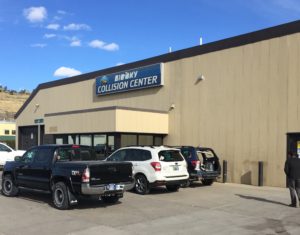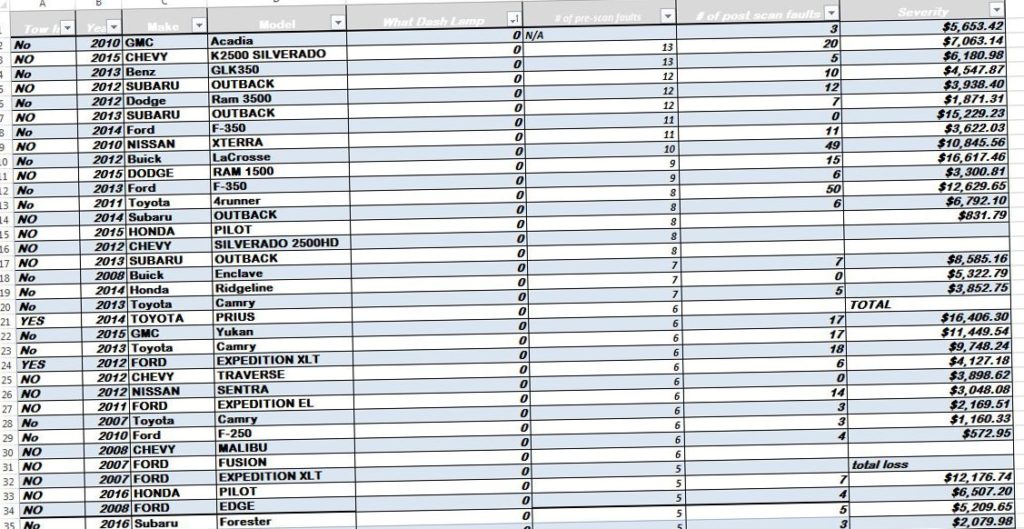
Mont. repairer’s diagnostics study shows ‘dash light’ myth, need for pre- and post- scans
By onBusiness Practices | Education | Repair Operations | Technology
For months, a Montana collision repairer kept statistics on his three shops’ repair orders to examine the necessity of pre- and post-repair scanning and whether the dash light can serve as an indicator of fault codes.
His findings from scanning more than 200 vehicles and comments in interviews this year bear out what OEMs have been saying: Vehicles require scanning, and the dash light is for customers, not auto repair professionals.
McDonnell Group President Matthew McDonnell, who uses one of Collision Diagnostic Services’ asTech devices, shared the results with us last month. They’re presented here with the customers, insurers, and repair order numbers redacted to protect privacy, and minor stylistic edits for easier sorting. Gaps in the data typically indicate vehicles received at the shop but which have not yet received a particular step in the repair process.
Here are some of the highlights of the study, which presents a template for other data-driven repairers to follow:
- Only about 14 percent of the 216 vehicles McDonnell’s staff scanned actually had a dash light on when it came into the shop. “About half of these dash lights were Tire Pressure Monitor and or maintenance lights not related to the repair,” McDonnell wrote in an email.
- About 80 percent of the vehicles without a dash light showing posted at least one fault code when scanned prior to the repair. Some threw as many as 13. “Scanning a vehicle (only) when there is a dash lamp is a myth and considered dangerous,” McDonnell wrote.
- Vehicles with fault codes but no dash lights encountered at the shop reached as far back as 2006 and into the 2017 model year (two Ford Escapes). OEMs say this condition can extend at least as far as the OBD-II standard in 1996.
- They included OEMs which had issued position statements on scanning and ones which hadn’t. The latter included makes such as Subaru, Ford/Lincoln, Audi, Mazda, Mitsubishi, Volkswagen, Kia. Also blasts from the past like a 2008 Saturn Vue and 2009 Pontiac G6.
- Post-repair scans found numerous additional faults, which is not surprising as the repair process itself generates fault codes. The record appears to have been claimed by a 2015 GMC K1500 Yukon, which amazingly came in with zero fault codes but had 107 following an extensive repair. (Severity was more than $16,000.)
The history
McDonnell said the scan study was a logical offshoot of an earlier attempt to study how well his estimators matched up, following a complaint that “your estimators are too different.”
He found a difference spanning several hours in their labor times, and concluded, “This isn’t good.”
“We really got calibrated,” he said, doing an extensive study of P-pages and OEM requirements.
The McDonnell Group later took an interest in scanning, and decided to perform a similar study to analyze the issue.
“We were really the tip of the spear here,” said McDonnell, who pointed out that scanning didn’t have the industry attention at that point.
The shop had an asTech scanner — “We just got lucky,” McDonnell said, by having something that could act like an OEM tool from the start — and it began to scan everything, comparing codes at intake with codes following the repair.
49 out of 50 cars came back with codes related to the repair or collision, which McDonnell called “another ‘Oh crap,’ moment.”
At that point, the McDonnell Group decided to check dash light data as well and collect subsequent findings in the spreadsheet. Technicians found that a vehicle typically needed a “pretty hard hit” before dash lights would appear. (McDonnell’s chart also details tow-in and five-figure repairs brought into the shop without dash lights but with pre-scan codes.)
Some OEMs, such as Nissan, only strongly recommend pre-repair scanning — but don’t mandate it. However, McDonnell said his technicians “live and die by the prescan” and the details it provides them about modules and parts requiring attention.
If you waited until the end of the repair to scan the car and found, “we have to replace this, this and this,” and start tearing the car back apart to do so, “who’s going to pay us to do that?” he said. (Not to mention the impact such a rework would have on cycle time, customer satisfaction and rental car bills — all of which affect an insurer as well.)
McDonnell’s study didn’t track dash lights encountered following the repair. “It makes me want to redo my Excel spreadsheet,” he said when asked about this.
However, asked if his staff saw many vehicles with a dash light on post-repair, he said “most times, no.” As the data show, diagnostic codes still existed unseen within the system.
McDonnell said that while there are “still guys saying it,” the misconception that diagnostic trouble codes always trigger dash lights seems to be dying among insurers.
Images:
Big Sky Collision, one of the McDonnell Group’s three shops in Montana, is shown. (Provided by the McDonnell Group)
For months, a Montana collision repairer kept statistics on his three shops’ repair orders to examine the necessity of pre- and post-repair scanning and whether the dash light can serve as an indicator of fault codes. (Provided by the McDonnell Group)

